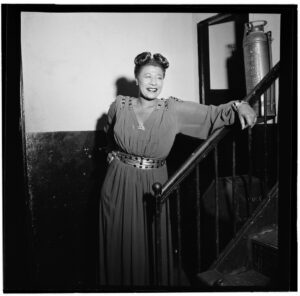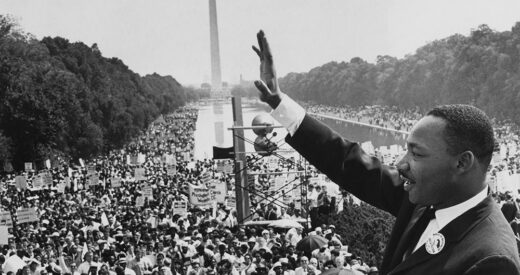“My dad can’t find out I’m lending this to you.”
My friend slips a record out of her father’s cabinet and hands it to me, cradling it in both hands like a velvet pillow upon which some priceless jewel might sit. I figure I should respond in kind and take it in both hands, so I do. It’s heavier than any record I’ve held before — a double LP with a thick booklet. On the cover, a gorgeous woman in a black turtleneck is holding sheet music, mid-note, giving side-eye to someone not pictured.
I take it home, set the first record onto my parents’ player, and drop the needle. Within thirty seconds, that voice is toying with an assemblage of horns, and I’m on the first of a thousand plays of “Ella Sings the Cole Porter Songbook, Volumes 1 & 2.”
I am twelve years old.
This isn’t my introduction to jazz. My mum has been playing it for me forever. It probably isn’t even the first time I’ve heard Ella Fitzgerald because my jazz-musician granddad mailed us mixtapes that I wore out.
But it is the first time I’ve sat with her, listened to only her, seen her face, and really taken a moment to drink her in. By track three – “Miss Otis Regrets” – I slide the LP out of its cloudy plastic sleeve to get a better look at her.
My parents had quite a few records, and the women singers pictured on them were usually smiling, shapely, dolled up, a little blank-eyed, or snapped singing, or broodily emoting. But the look on Ella’s face. The black turtleneck. The mischievous side-eye. There is something else going on here. (If you don’t know the LP cover I’m talking about, go right now and Google it.)
Later, I find out there are plenty of side-eye-slinging early women performers. Later, I see Judy Garland dressed as a clown, hear Bessie Smith singing about gin, and discover a hundred more examples of women who stood out because they didn’t fit in. But at this point, it’s the early days, and here’s this woman singing about birds doing it, bees doing it, even educated fleas doing it (long before I’m clear on what “doing it” entails), and somehow she manages to sing these hyper-sexualized lyrics without becoming sexualized herself. If anything, she sounds knowingly bemused by the whole idea. I’m not able to connect these dots back then, of course — still, something shakes loose in my prepubescent mind.
Over the years, as I’ve listened to hundreds of her recordings and read more about her life, I’ve figured out what Ella Fitzgerald means to me.

The vocal precision, sure. Her timing is insane. And she loved songs. As someone who championed composers and their songbooks, Ella Fitzgerald became an ambassador for tunes that tell a story: lyrics that mean something, the universal truths that tug, no matter how old a song may be.
This year, we’re celebrating what would have been Ella’s 100th birthday. By all accounts, hers was a life devoid of drugs, alcohol, and public meltdowns. From what we think we know, she had her own demons, but not in the way Billie Holiday or Frank Sinatra had theirs, constantly haunted and hunted. She’s one of the reasons I don’t believe that old trope that you need to be a tortured, hot mess of a human to create great art.
But more than all of that, Ella singing is pure joy.
The idea of “playing” music – playing like it’s a game – feels more true with some musicians than with others, and even in moodier numbers, she was always playing: with notes, with time, with emotions, but subtly and subversively, like she knew instinctively not to lead with it. And that joy is what makes Ella Fitzgerald a one-person masterclass in soft power.
Listening to Billie Holiday or Judy Garland, I hear raw vulnerability: souls exorcizing their demons. And vulnerability is its own gift, to be sure. But Ella’s gift is something else. It’s the gift of knowing your stuff and having fun with it, whether people approve or not.
Not needing approval is maybe the ultimate power move, especially for women.
It didn’t surprise me one bit to learn that, as the singer for Chick Webb’s orchestra at the time of his death, Ella took over and fronted the (as far as I know, all-male) band for nearly 3 years, in 1939, when she was only 23 years old.
Pause and let’s think about that for a minute – about what it probably took to ringlead a dozen or so men as an upstart lady singer, barely two decades after women got the vote. This isn’t why Ella Fitzgerald’s important to jazz, and it’s not what made her an icon, but it’s key to both.
Later, she went on to run her own band, and the rest of her towering career followed. Even though she worked with producers and managers throughout, her voice was her own, and with it, she had plenty to say. So I always go back to Ella, as a musician and as a woman. Even adjusting for the times, being a woman leader in music still requires some fancy footwork in 2022, if you’re going to have a voice.
It requires soft power. It requires a little side-eye.
Throughout Women’s History Month and beyond, there are millions and millions of women who deserved to be profiled for the greatness they achieved. But this one is from me to Ella.
Ella, here’s to you, and here’s to the way you’ve inspired generations of children and adults to find their joy and their power, through music and through so much more.
Who are you celebrating this Women’s History Month? Share this article on Linkedin and tag us to let us know which women have inspired your own joy, power, confidence, and excellence.
Elizabeth Bougerol is the lead singer and co-band leader of the jazz band, The Hot Sardines.






